2023届高考英语二轮复习:动词性结构 时态和语态 课件(24张)
文档属性
| 名称 | 2023届高考英语二轮复习:动词性结构 时态和语态 课件(24张) | 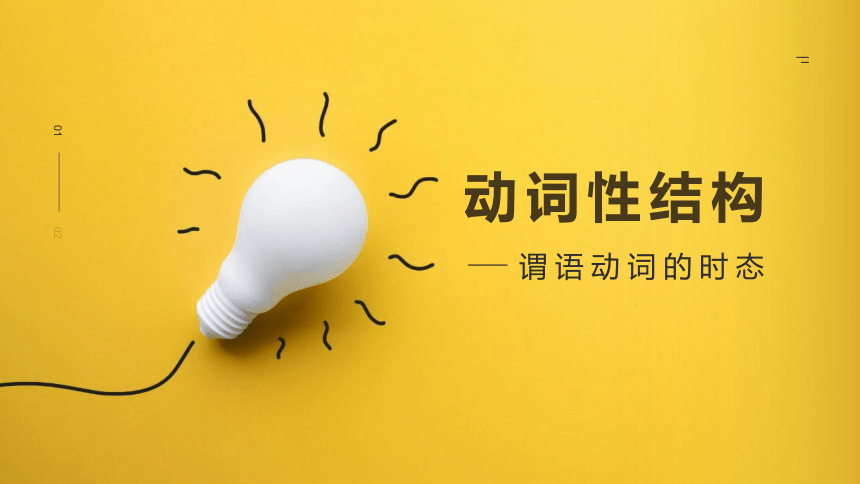 | |
| 格式 | zip | ||
| 文件大小 | 228.1KB | ||
| 资源类型 | 教案 | ||
| 版本资源 | 通用版 | ||
| 科目 | 英语 | ||
| 更新时间 | 2022-09-02 08:18:11 | ||
图片预览


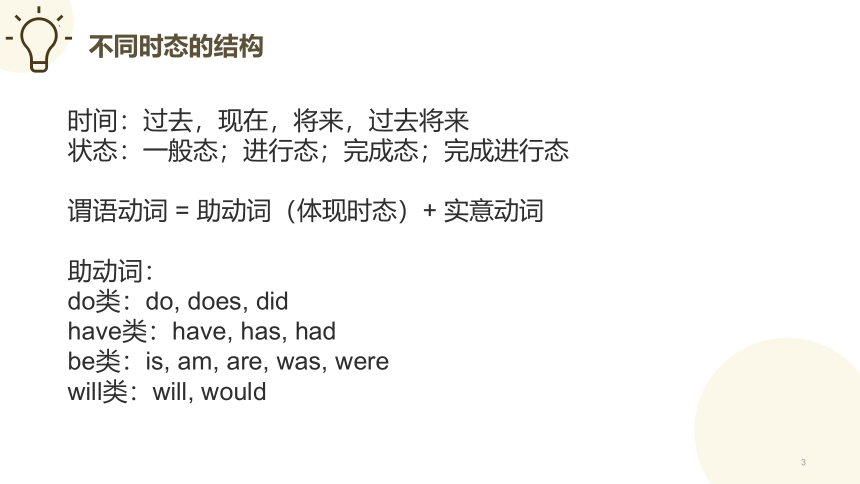
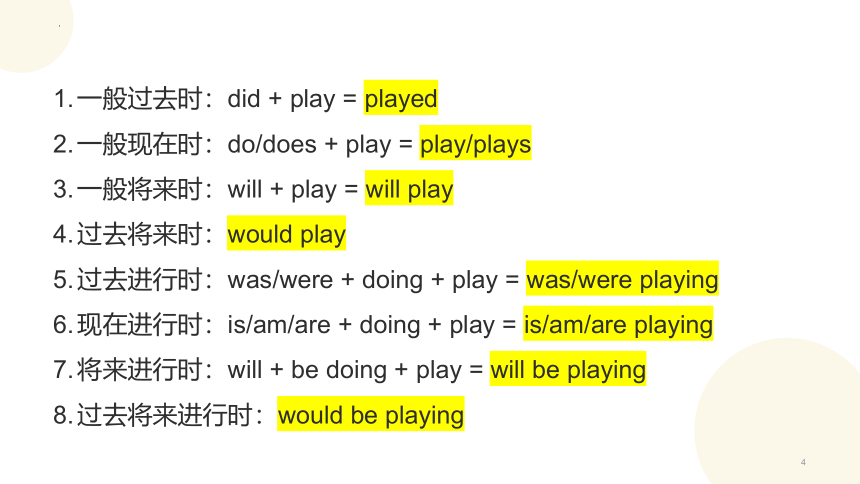


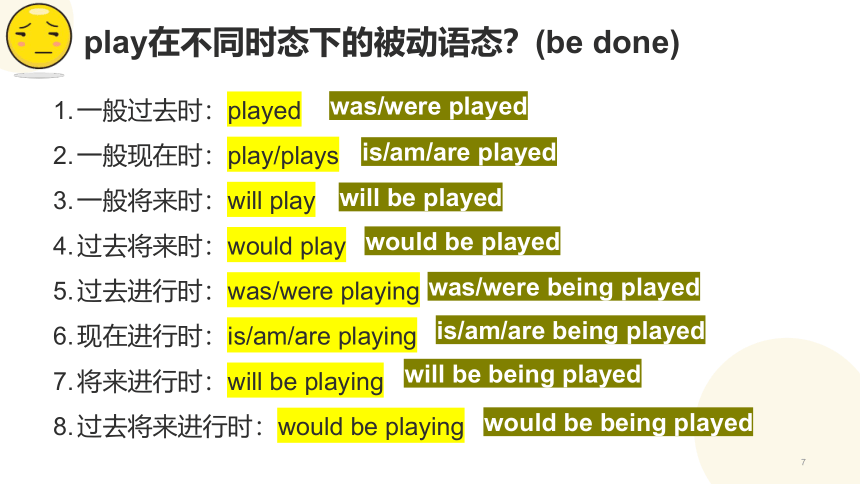
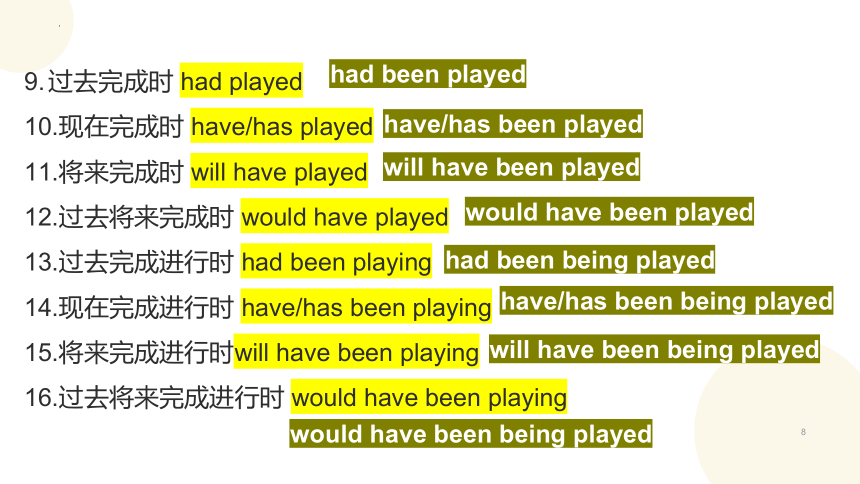
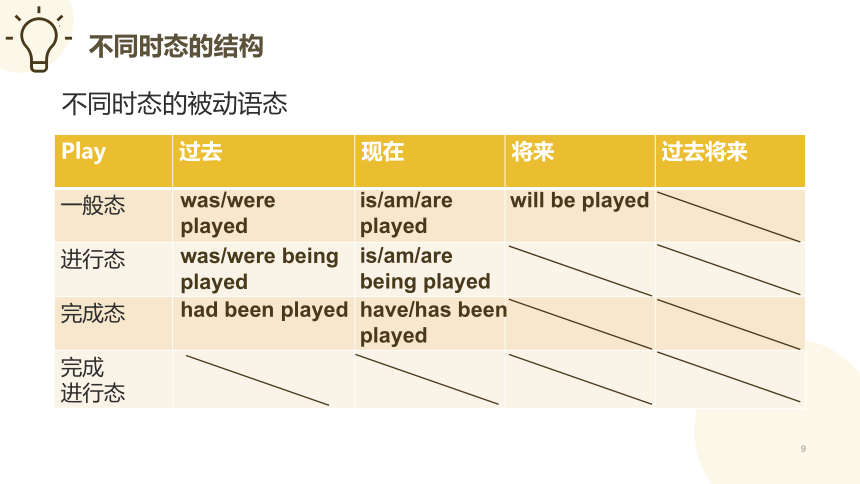
文档简介
(共24张PPT)
动词性结构
谓语动词的时态
01
02
2
动作发出者的核心动作。
谓语动词是什么?
一个句子有几个谓语啊?
一个句子只有一个主谓;如果由两个谓语就要加连词!
谓语动词的时态是怎样体现的?
时间和语态的结合就是时态。
3
不同时态的结构
时间:过去,现在,将来,过去将来
状态:一般态;进行态;完成态;完成进行态
谓语动词 = 助动词(体现时态)+ 实意动词
助动词:
do类:do, does, did
have类:have, has, had
be类:is, am, are, was, were
will类:will, would
4
一般过去时:did + play = played
一般现在时:do/does + play = play/plays
一般将来时:will + play = will play
过去将来时:would play
过去进行时:was/were + doing + play = was/were playing
现在进行时:is/am/are + doing + play = is/am/are playing
将来进行时:will + be doing + play = will be playing
过去将来进行时:would be playing
5
过去完成时 = had + done + play = had played
现在完成时 = have/has + done + play = have/has played
将来完成时 = will + have done + play = will have played
过去将来完成时 = would have played
过去完成进行时 = had done + be doing + play = had been playing
现在完成进行时 = have/has done +be doing + play = have/has been playing
将来完成进行时=will+ have done+ be doing + play =will have been playing
过去将来完成进行时 = would have been playing
6
不同时态的结构
不同的时态
Play 过去 现在 将来 过去将来
一般态 played play/plays will play
进行态 was/were playing is/am/are playing
完成态 had playing have/has playing
完成进行态 have/has been playing
7
play在不同时态下的被动语态?(be done)
一般过去时:played
一般现在时:play/plays
一般将来时:will play
过去将来时:would play
过去进行时:was/were playing
现在进行时:is/am/are playing
将来进行时:will be playing
过去将来进行时:would be playing
was/were played
is/am/are played
will be played
would be played
was/were being played
is/am/are being played
will be being played
would be being played
8
过去完成时 had played
现在完成时 have/has played
将来完成时 will have played
过去将来完成时 would have played
过去完成进行时 had been playing
现在完成进行时 have/has been playing
将来完成进行时will have been playing
过去将来完成进行时 would have been playing
had been played
have/has been played
will have been played
would have been played
had been being played
have/has been being played
will have been being played
would have been being played
9
不同时态的结构
不同时态的被动语态
Play 过去 现在 将来 过去将来
一般态
进行态
完成态
完成 进行态
was/were
played
is/am/are
played
will be played
was/were being
played
is/am/are
being played
had been played
have/has been
played
10
常考时态的用法与识别标志
一般现在时
构成:动词原形;-s/;变y为i再加es;-es(以o,s,x,ch,sh结尾的单词)
;以辅音字母加y结尾的动词,要先将y变为i然后再加es;
用法:
客观事实。
Giant panda ______(love) by people throughout the world.
表示习惯性,永久性或反复发生的动作。
标志词:often, usually, always, every week, day after day, on Sundays.
Leaving the less important thing until tomorrow ______(be) often acceptable.
is loved
is
11
常考时态的用法与识别标志
一般现在时
用法:
3. 其他一直动词为一般现在时,保持时态一致。标志:已知动词
When every pupil in the school wears the uniform, nobody _____(have) to worry about fashion.
This is why decorating with paints, fruits and flowers _____(carry) special significance.
4. 表现现在瞬间。标志:now, at the moment
But at the moment, school _______(come) first.
has
carries
comes
12
常考时态的用法与识别标志
一般过去时
构成:-(e)d;动词不规则变化
用法:
其他一直动词为一般过去时,保持时态一致。标志:已知动词
In 1969, the pollution was …It ____(be) unimaginable that it could be ever cleaned up.
2. 有与过去相关的时间词和其他词。
I _____(see) him in the street yesterday.
was
saw
1、一般情况下,动词原形词尾加 -ed
如:work ---worked play---played wanted----wanted act----acted
2、以不发音的 -e 结尾动词,动词词尾加 -d
如:live---lived move----moved taste---tasted hope---hoped
3、以辅音字母 + y结尾的动词,把-y变为-i 再加-ed
如:study---studied copy---copied cry---cried carry---carried
4、以一个辅音字母结尾的重读闭音节动词,双写词尾辅音字母,再加 –ed
如:stop ---stopped plan---planned
13
常考时态的用法与识别标志
一般将来时
构成:will do; be going to do; be to do; be about to do
用法:
将来发生的动作或存在的状态。
某些动词的现在进行时表示按计划或安排将要进行的动作。
我来了。我走了。
I’ m coming. I’ m leaving.
14
常考时态的用法与识别标志
过去将来时
构成:would do; was/were going to do; was/were to do;
was/were about to do
用法:
表示从过去某事看将要发生的动作或存在的状态。
Barak Obama did’ t know he ________(become) the first black president of The United States.
would become
15
常考时态的用法与识别标志
现在进行时
构成:am/is/are doing
用法:
表示现在或现阶段正在进行的事或发生的动作。
1) When the children are walking or _______(cycle) to school…
2) Currently, about 35,000 works ________(display) in over 300 rooms in the Louvre, and it would take a lifetime to see everything.
cycling
are being displayed
16
常考时态的用法与识别标志
过去进行时
构成:was/were doing
用法:
表示过去某一时刻或过去某个阶段正在进行的事或发生的动作。
He fell asleep when he was reading.
We were watching TV from seven to nine last night.
He was cleaning his car while I was cooking.
17
常考时态的用法与识别标志
现在完成时
构成:have/has done (注意过去分词不规则变形)
用法:
过去的动作或状态持续到现在,或对现在造成的影响
标志词(时间状语):since, ever since, in recent days/weeks/ months/years, recently, lately, over the years, for + 时间段, these days, in/over/during the last/past + 时间段, up to now, so far, yet.
_____ he ______ (finish) his work today Not yet.
Since he _______(graduate) from the university, He _______(work) for the company for 10 years.
Has
finished
graduated
has worked
since时间状语从句中,主句用现在完成时,从句用一般过去时
18
常考时态的用法与识别标志
现在完成时
构成:have/has done (注意过去分词不规则变形)
didn’ t come
3) He ______(not come) since he was busy.
4) He _____(work) in India for two years, but now he works in China.
since还可以引导原因状语从句,此时时态不一定用现完
worked
19
常考时态的用法与识别标志
过去完成时
构成:had done (注意过去分词不规则变形)
用法:
表示发生在过去某个动作或时间之间,即过去的过去。
情景一:两个动作,有先后之分。要填的通常为之前的动作。
I was just going to move away the heavy case but someone _______(do) it. Was it you
情景二:题中有一个过去的时间,唯一的谓语挖空,且该动作发生在这个过去的时间前。
Experiments of this kind _________(conduct) in both the U.S and Europe well before the Second World War.
had done
had been conducted
20
常考时态的用法与识别标志
现在完成进行时
构成:have/has been doing
用法:
表示动作从过去持续到现在,并在将来继续持续下去。
I have been waiting for an hour but she still hasn ‘t come.
21
by + 时间点
by+过去的时间时,主句要用过去完成时。
by+现在的时间时,主句用现在完成时。
by加将来的时间,主句用将来完成时。
1) By the end of this month, I ________(finish) my homework.
2) By the time we arrived, someone ________(grab) all the good seats.
will have finished
had grabbed
22
考点一:语法填空中考查谓语的时态和语态
In the last five years. Cao _________(walk) through 34 countries in six continents, and in 2016, he reached the top of Kilimanjaro, Africa’s highest mountain.
The plan will extend protection to a significant number of areas that _______(be) previously unprotected.
The GPNP _________ (design) to reflect the guiding principle of protecting the authenticity and integrity (完整性) of natural ecosystems.
What comes next is the endless series of steps. You can’t help wondering how hard it ________ (be) for the people then to put all those rocks into place.
After Lincoln________(elect) President of the US in 1860, they rented the house and _______(sell) most of their furniture.
It ______(build) originally to protect the city in the Tang dynasty and has now been completely restored.
has walked
were
is/was designed
及物动词后无宾语即为被动
was
was elected
sold
was built
and并列结构前后时态基本一致
23
考点一:语法填空中考查谓语的时态和语态
It doesn‘t impress like George Washington’s plantation on the Potomac, but Lincoln‘s home in downtown Springfield, Illinois, ________ (prove) irresistible(不可抵抗的) to visitors since it opened to the public.
It is calculated by dividing a person’s weight in kg by their height in meters squared, and a BMI of between 19 and 25 __________(consider) healthy.
The unmanned Chang'e-4 probe (探测器) —the name was inspired by an ancient Chinese moon goddess _______(touch) down last week in the South Pole-Aitken basin.
"This really excites scientists,"Carle Pieters, a scientist at Brown University, says,"because it______(mean) we have the chance to obtain information about how the moon______(construct).“
The artist was sure he would______(choose), but when he presented his masterpiece to the emperor’s chief minister, the old man laughed.
has proved
prove主动表示被动
divide A by B A除B
is considered
touched
means
is constructed
be chosen
24
考点一:语法填空中考查谓语的时态和语态
When he asked the villagers on the banks of the river where he could find the legendary artist, they smiled and_______(point) down the river.
And, as more children were born, more food ________(need).
By about 6000 BC, people ________(discover)the best crops to grow and animals to raise.
New methods _______(mean) that fewer people worked in farming.
The 80,000 objects collected by Sir Hans Sloane, for example, _______(form) the core collection of the British Museum which opened in 1759.
The parts of a museum open to the public _______(call) galleries or rooms.
—You are a great swimmer.
—Thanks. It’s because I ________(practice) a lot these days.
If you look at all sides of the situation, you'll find probably a solution that _______(suit) everyone.
pointed
was needed
had discovered
meant
formed
are called
have been practicing
suits
动词性结构
谓语动词的时态
01
02
2
动作发出者的核心动作。
谓语动词是什么?
一个句子有几个谓语啊?
一个句子只有一个主谓;如果由两个谓语就要加连词!
谓语动词的时态是怎样体现的?
时间和语态的结合就是时态。
3
不同时态的结构
时间:过去,现在,将来,过去将来
状态:一般态;进行态;完成态;完成进行态
谓语动词 = 助动词(体现时态)+ 实意动词
助动词:
do类:do, does, did
have类:have, has, had
be类:is, am, are, was, were
will类:will, would
4
一般过去时:did + play = played
一般现在时:do/does + play = play/plays
一般将来时:will + play = will play
过去将来时:would play
过去进行时:was/were + doing + play = was/were playing
现在进行时:is/am/are + doing + play = is/am/are playing
将来进行时:will + be doing + play = will be playing
过去将来进行时:would be playing
5
过去完成时 = had + done + play = had played
现在完成时 = have/has + done + play = have/has played
将来完成时 = will + have done + play = will have played
过去将来完成时 = would have played
过去完成进行时 = had done + be doing + play = had been playing
现在完成进行时 = have/has done +be doing + play = have/has been playing
将来完成进行时=will+ have done+ be doing + play =will have been playing
过去将来完成进行时 = would have been playing
6
不同时态的结构
不同的时态
Play 过去 现在 将来 过去将来
一般态 played play/plays will play
进行态 was/were playing is/am/are playing
完成态 had playing have/has playing
完成进行态 have/has been playing
7
play在不同时态下的被动语态?(be done)
一般过去时:played
一般现在时:play/plays
一般将来时:will play
过去将来时:would play
过去进行时:was/were playing
现在进行时:is/am/are playing
将来进行时:will be playing
过去将来进行时:would be playing
was/were played
is/am/are played
will be played
would be played
was/were being played
is/am/are being played
will be being played
would be being played
8
过去完成时 had played
现在完成时 have/has played
将来完成时 will have played
过去将来完成时 would have played
过去完成进行时 had been playing
现在完成进行时 have/has been playing
将来完成进行时will have been playing
过去将来完成进行时 would have been playing
had been played
have/has been played
will have been played
would have been played
had been being played
have/has been being played
will have been being played
would have been being played
9
不同时态的结构
不同时态的被动语态
Play 过去 现在 将来 过去将来
一般态
进行态
完成态
完成 进行态
was/were
played
is/am/are
played
will be played
was/were being
played
is/am/are
being played
had been played
have/has been
played
10
常考时态的用法与识别标志
一般现在时
构成:动词原形;-s/;变y为i再加es;-es(以o,s,x,ch,sh结尾的单词)
;以辅音字母加y结尾的动词,要先将y变为i然后再加es;
用法:
客观事实。
Giant panda ______(love) by people throughout the world.
表示习惯性,永久性或反复发生的动作。
标志词:often, usually, always, every week, day after day, on Sundays.
Leaving the less important thing until tomorrow ______(be) often acceptable.
is loved
is
11
常考时态的用法与识别标志
一般现在时
用法:
3. 其他一直动词为一般现在时,保持时态一致。标志:已知动词
When every pupil in the school wears the uniform, nobody _____(have) to worry about fashion.
This is why decorating with paints, fruits and flowers _____(carry) special significance.
4. 表现现在瞬间。标志:now, at the moment
But at the moment, school _______(come) first.
has
carries
comes
12
常考时态的用法与识别标志
一般过去时
构成:-(e)d;动词不规则变化
用法:
其他一直动词为一般过去时,保持时态一致。标志:已知动词
In 1969, the pollution was …It ____(be) unimaginable that it could be ever cleaned up.
2. 有与过去相关的时间词和其他词。
I _____(see) him in the street yesterday.
was
saw
1、一般情况下,动词原形词尾加 -ed
如:work ---worked play---played wanted----wanted act----acted
2、以不发音的 -e 结尾动词,动词词尾加 -d
如:live---lived move----moved taste---tasted hope---hoped
3、以辅音字母 + y结尾的动词,把-y变为-i 再加-ed
如:study---studied copy---copied cry---cried carry---carried
4、以一个辅音字母结尾的重读闭音节动词,双写词尾辅音字母,再加 –ed
如:stop ---stopped plan---planned
13
常考时态的用法与识别标志
一般将来时
构成:will do; be going to do; be to do; be about to do
用法:
将来发生的动作或存在的状态。
某些动词的现在进行时表示按计划或安排将要进行的动作。
我来了。我走了。
I’ m coming. I’ m leaving.
14
常考时态的用法与识别标志
过去将来时
构成:would do; was/were going to do; was/were to do;
was/were about to do
用法:
表示从过去某事看将要发生的动作或存在的状态。
Barak Obama did’ t know he ________(become) the first black president of The United States.
would become
15
常考时态的用法与识别标志
现在进行时
构成:am/is/are doing
用法:
表示现在或现阶段正在进行的事或发生的动作。
1) When the children are walking or _______(cycle) to school…
2) Currently, about 35,000 works ________(display) in over 300 rooms in the Louvre, and it would take a lifetime to see everything.
cycling
are being displayed
16
常考时态的用法与识别标志
过去进行时
构成:was/were doing
用法:
表示过去某一时刻或过去某个阶段正在进行的事或发生的动作。
He fell asleep when he was reading.
We were watching TV from seven to nine last night.
He was cleaning his car while I was cooking.
17
常考时态的用法与识别标志
现在完成时
构成:have/has done (注意过去分词不规则变形)
用法:
过去的动作或状态持续到现在,或对现在造成的影响
标志词(时间状语):since, ever since, in recent days/weeks/ months/years, recently, lately, over the years, for + 时间段, these days, in/over/during the last/past + 时间段, up to now, so far, yet.
_____ he ______ (finish) his work today Not yet.
Since he _______(graduate) from the university, He _______(work) for the company for 10 years.
Has
finished
graduated
has worked
since时间状语从句中,主句用现在完成时,从句用一般过去时
18
常考时态的用法与识别标志
现在完成时
构成:have/has done (注意过去分词不规则变形)
didn’ t come
3) He ______(not come) since he was busy.
4) He _____(work) in India for two years, but now he works in China.
since还可以引导原因状语从句,此时时态不一定用现完
worked
19
常考时态的用法与识别标志
过去完成时
构成:had done (注意过去分词不规则变形)
用法:
表示发生在过去某个动作或时间之间,即过去的过去。
情景一:两个动作,有先后之分。要填的通常为之前的动作。
I was just going to move away the heavy case but someone _______(do) it. Was it you
情景二:题中有一个过去的时间,唯一的谓语挖空,且该动作发生在这个过去的时间前。
Experiments of this kind _________(conduct) in both the U.S and Europe well before the Second World War.
had done
had been conducted
20
常考时态的用法与识别标志
现在完成进行时
构成:have/has been doing
用法:
表示动作从过去持续到现在,并在将来继续持续下去。
I have been waiting for an hour but she still hasn ‘t come.
21
by + 时间点
by+过去的时间时,主句要用过去完成时。
by+现在的时间时,主句用现在完成时。
by加将来的时间,主句用将来完成时。
1) By the end of this month, I ________(finish) my homework.
2) By the time we arrived, someone ________(grab) all the good seats.
will have finished
had grabbed
22
考点一:语法填空中考查谓语的时态和语态
In the last five years. Cao _________(walk) through 34 countries in six continents, and in 2016, he reached the top of Kilimanjaro, Africa’s highest mountain.
The plan will extend protection to a significant number of areas that _______(be) previously unprotected.
The GPNP _________ (design) to reflect the guiding principle of protecting the authenticity and integrity (完整性) of natural ecosystems.
What comes next is the endless series of steps. You can’t help wondering how hard it ________ (be) for the people then to put all those rocks into place.
After Lincoln________(elect) President of the US in 1860, they rented the house and _______(sell) most of their furniture.
It ______(build) originally to protect the city in the Tang dynasty and has now been completely restored.
has walked
were
is/was designed
及物动词后无宾语即为被动
was
was elected
sold
was built
and并列结构前后时态基本一致
23
考点一:语法填空中考查谓语的时态和语态
It doesn‘t impress like George Washington’s plantation on the Potomac, but Lincoln‘s home in downtown Springfield, Illinois, ________ (prove) irresistible(不可抵抗的) to visitors since it opened to the public.
It is calculated by dividing a person’s weight in kg by their height in meters squared, and a BMI of between 19 and 25 __________(consider) healthy.
The unmanned Chang'e-4 probe (探测器) —the name was inspired by an ancient Chinese moon goddess _______(touch) down last week in the South Pole-Aitken basin.
"This really excites scientists,"Carle Pieters, a scientist at Brown University, says,"because it______(mean) we have the chance to obtain information about how the moon______(construct).“
The artist was sure he would______(choose), but when he presented his masterpiece to the emperor’s chief minister, the old man laughed.
has proved
prove主动表示被动
divide A by B A除B
is considered
touched
means
is constructed
be chosen
24
考点一:语法填空中考查谓语的时态和语态
When he asked the villagers on the banks of the river where he could find the legendary artist, they smiled and_______(point) down the river.
And, as more children were born, more food ________(need).
By about 6000 BC, people ________(discover)the best crops to grow and animals to raise.
New methods _______(mean) that fewer people worked in farming.
The 80,000 objects collected by Sir Hans Sloane, for example, _______(form) the core collection of the British Museum which opened in 1759.
The parts of a museum open to the public _______(call) galleries or rooms.
—You are a great swimmer.
—Thanks. It’s because I ________(practice) a lot these days.
If you look at all sides of the situation, you'll find probably a solution that _______(suit) everyone.
pointed
was needed
had discovered
meant
formed
are called
have been practicing
suits
